- DGK Viper 8.125 Deck Review: An Overall Good Board - April 20, 2022
- Best Skateboard Bearings Guide: All You Need Consider - January 27, 2022
- Most Famous Old School Skateboarders - January 27, 2022
If there is one thing you can’t take for granted in skateboarding, it’s that a trick will remain at the top of the setlist.
When putting a run together for a competition or just for an Instagram reel, you may find that a trick that was unparalleled months ago now has even more complex variants and twice many little details to replicate.
Meaning that you’ll need to match the same level of style and nuance if you want to keep the bragging rights at your local park. This means that you’ll need to explore the different options you have for making your trick look better and harder.
One trick that is a great example of this is a fakie flip. A fakie flip combines an awkward stance with a standard flip trick, cranking the difficulty up a notch and allowing skaters to add to their catalogue of tricks without really learning any new movements.
However, you may be wondering what a fakie flip is if there are other variations of this trick, where this trick originated from, and most importantly, how to do this trick.
Well, that’s where we come in. We have put together this guide so you can nail this trick and learn all there is to know about this trick. So without further delay, here is our guide on how to fakie flip.
What is a Fakie Flip?
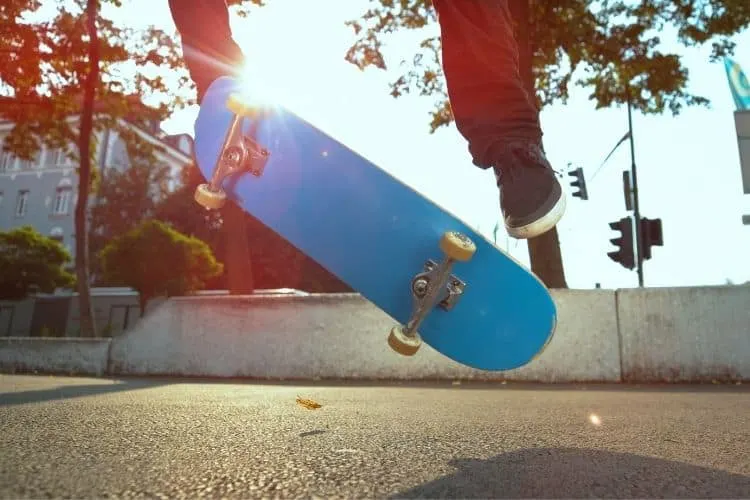
A fakie flip is a general term that can refer to several tricks. The only things that are required to call a trick a fakie flip are completing the trick while rolling in the fakie stance and doing a flip trick. So, in theory, we suppose this would mean that a fakie Lazer flip would technically be a fakie flip.
However, when a skater refers to a fakie flip, you will find that they are often referring to a kickflip in the fakie stance. This can sometimes apply for fakie heelflips, but like with many tricks, this is usually differentiated by referring to this trick as a ‘Fakie heel’.
What is Fakie?
Just in case you aren’t sure what the term ‘Fakie’ means, we won’t leave you in the dark any longer. Fakie is a term that refers to a specific skateboarding stance. This is when the skater is standing in their standard, most comfortable position, with their dominant foot on the tail and the flicking foot near the nose.
However, to make this fakie, the skater must be riding backwards. This often means that tricks in the fakie stance are practically the same as their standard counterparts. However, the fakie stance will ask a lot of skaters in terms of balance and weight distribution.
Who Invented the Fakie Flip?
It’s a great question, and it’s not one that we can truly answer. However, we can certainly have an educated guess. As this is merely traveling backwards while doing a kickflip, we would say the chances are high that the grandfather of skating, Rodney Mullen, created this trick.
Rodney was responsible for creating a huge amount of the modern flat ground tricks that skaters commonly perform today. One of which was the ‘magic flip’ which we now refer to as a kickflip.
The alternative name was given to this trick as in the 1980s, many skaters would do a kickflip by hooking their toes under the board while standing facing forward, then jumping. This is now known as the old skool kickflip.
Rodney created this trick when he was living in Florida at the age of sixteen, and if we were betting people, we would say that Rodney almost certainly rode backwards and gave this one a try before anyone else.
Are There Any Variations of the Fakie Flip?
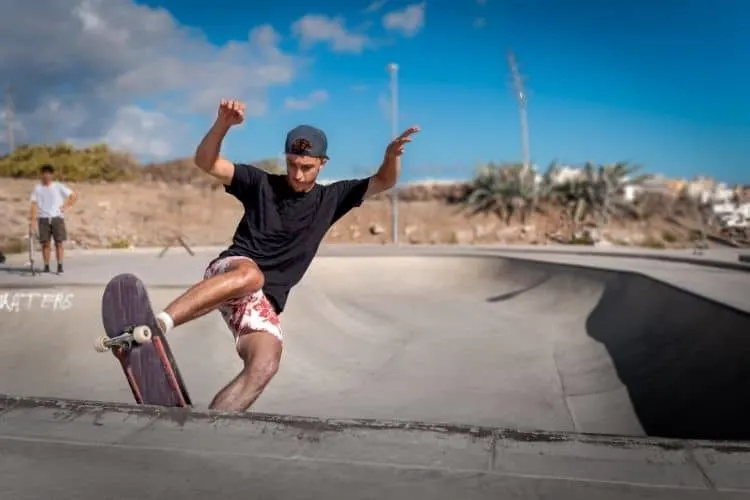
Yes, there are a number of variations that come from the standard fakie flip. These tend to be versions of this trick, with one particular factor of difficulty added. Here is a quick list of all the variations out there:
FS/BS Half Cab Flips
The most common variation of this trick is the half cab flip. This is when you perform a fakie kickflip but add a 180-degree rotation in the direction of your choice.
This is a very natural progression to a standard fakie flip as, due to the backwards momentum of the stance, your board will almost naturally want to rotate around. So with a little more encouragement from you, the board will make a half-turn, and you’ll land a half cab flip.
Caballerial Flips
This is a progression of the trick listed above. This is when the skater flicks a fakie flip. However, this becomes a caballerial flip when the skater also does a full 360-degree rotation. A caballerial is when a skater rides fakie and completes a full 360-degree rotation and was invented by none other than Steve Caballero.
Fakie Varials
This is a variation that adds a 180-degree spin on top of the kickflip rotation to create a varial motion. This combines a backside shuv-it and a kickflip while riding in the fakie stance.
Fakie 360 Flips
This is a progression on the trick listed above. This is when the skater will combine a kickflip and a backside 360 shuv-it, allowing the board to rotate 360 degrees along both axis before landing in style. This all occurs while the skater rides fakie.
Fakie Hospital Flips
This is a much more technical version of the standard trick. For this to come off, the skater will begin riding a fakie and flick a fakie flip. However, as soon as the board has made half a rotation, they will wrap their foot around the nose, hook the board over and land as normal.
Fakie Double Flips
As the name suggests, this is when the skater performs a fakie flip, but instead of landing after one rotation, the skater must hang in the air. This allows the board to rotate twice in the air, and then the skater catches the board and rides away.
Fakie Underflips
Then lastly, we have fakie under flips. These are when the skater does a fakie flip to completion. Then while the board is still in the air, they flick the board in the direction it came, reversing the rotation while still in the air, then landing when the board makes its way back around.
What Tricks Do I Need to Know Before Trying a Fakie Flip
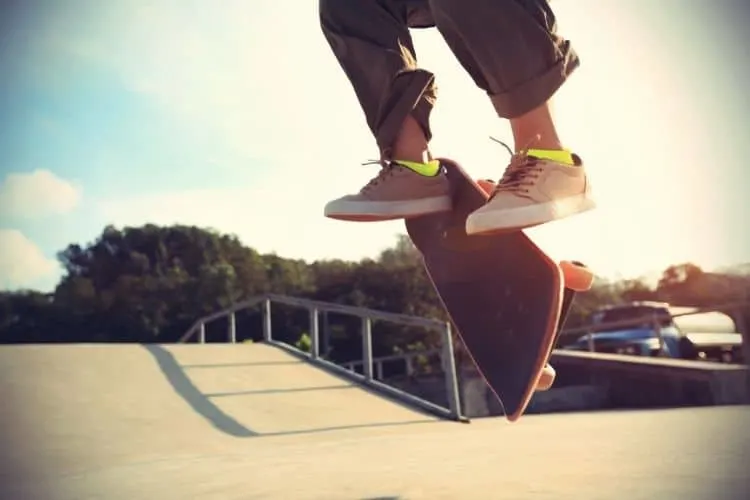
While there are some tricks out there where you can try right off the bat, we would say that fakie flips aren’t one of those. To do a fakie flip, you need to have mastery of most of the basic skills on a board. Plus, you need to have perfected a couple of basic tricks too.
In terms of beginner skills, we would say that you need to be able to ride, stop and turn comfortably. We would advise skaters to know how to do a sex change while moving, and we would also suggest that skaters learn how to ride fakie without any hassle.
Then as for the tricks that we would describe as non-negotiable. We would say that without a decent ollie, you have little chance of landing a fakie flip, so if you don’t have this one locked in, practice this first.
Then we would also say that skaters should know how to fakie ollie and be able to add rotations such as half cabs and FS/BS 180s for added comfort when learning to fakie flip. If you have all of this in your locker, you could absolutely try to land your first fakie flip.
That being said, there are some tricks that, while not essential, could help you land a fakie flip quicker. Here is a quick list of all the tricks we would recommend learning before a fakie flip:
- Ollie
- Fakie Ollie
- Sex change
- FS/BS 180
- Pop shuv-it
- Fakie pop-shuv-it
- Fakie big spin
- Half cabs
- Nollies
- Switch ollies
- Heelflips
- Manuals
- Reverts
- Powerslides
- Kickturns
How to Fakie Flip: A Guide
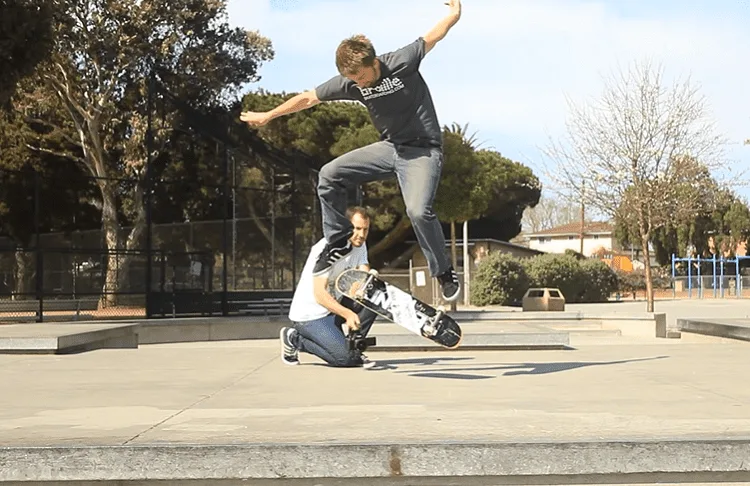
Now that you have a firmer understanding of what a fakie flip is, what you need to have in your skating repertoire before you try this one, and what variations of this trick are out there.
We think it’s about time we taught you how to learn this trick. We have put together a handy step-by-step guide that will show you the best way to go about doing this trick and master your first flip trick in the fakie stance. Here is the guide below:
Step One
The first thing you’ll want to do is get your feet in the right position for this trick. If you are familiar with the standard kickflip, this is really no different. The skater will stand with their dominant foot on the tail, ready to pop the trick, and then the other foot will be placed around the truck bolts nearest the nose of the board.
The flicking foot will be hanging off the side of the board closest to you with your toes and the ball of your foot remaining on the grip tape.
It can also be helpful to angle your foot at a 45-degree angle facing the nose of the board. This will allow the board to rotate around faster. Experiment with this if you feel it might help you land this trick more consistently.
Step Two
The next thing you’ll need to do is get your body set for this trick. This means you’ll need to stand up tall, keep your head up, square your shoulders and keep a solid posture throughout the trick.
This is most important before the pop as, if riding fakie, it’s much easier to lose balance or distribute your weight incorrectly, making the trick impossible.
It’s also important to be riding at a moderate pace. With fakie tricks, riding too slow will often lead to inadequate pops.
Step Three
After this, you will want to bend down and pop the board. While you do this, you’ll want to keep your body leaning slightly closer to your flicking foot. This will allow you to stay over the board without it shooting behind you or slipping out from under you after a shaky landing.
Step Four
After popping the board, you’ll want to carry out the typical kickflip motion. You will slide your flicking foot up the grip tape and then use your ankle to flick off at the inside pocket of the nose.
This will allow the board to complete a full rotation in the air. While the board rotates, the skater should try to keep their knees tucked into the chest, hanging in the air and staying out of the way of the board as it moves.
Step Five
After the board has completed a full rotation, you will need to catch the board. This is usually easier with the flicking foot but can be done with either.
Then simply bend your knees upon impact with the ground to absorb the shock. If you have completed all the steps, then you should be rolling away, having just landed a successful fakie flip.
Most Common Mistakes When Learning to Fakie Flip
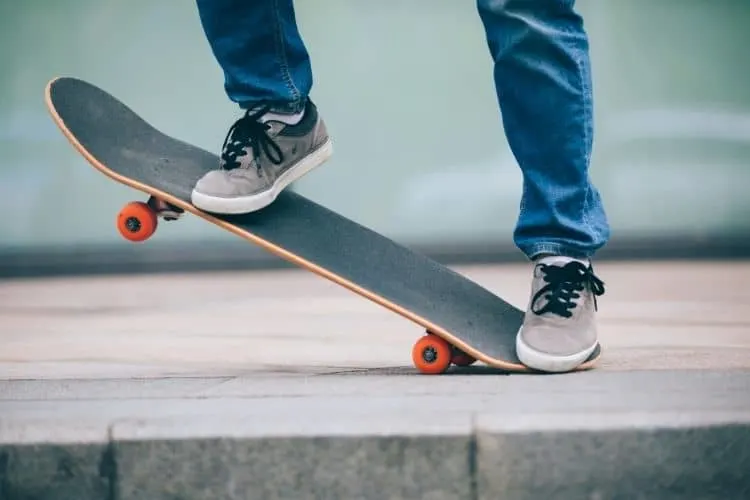
We hope that following the steps above was enough to secure your first fakie flip. However, if you are still having trouble with the execution here, don’t panic.
As with just about every trick, there are a few common errors that some skaters fall victim to, meaning that they won’t be able to land this trick until they identify the problem. That’s why we have taken the time to identify the common issues, allowing you to tweak the formula and land this trick. Here they are listed below:
Poor Flicking Technique
The flicking technique is one of the most common issues with a fakie kickflip, much like a standard kickflip. What we mean by this is that some skaters won’t guide their feet up the grip and flick off the inside pocket. Instead, they will fakie ollie, level out and then kick down on the side of the board.
This can work, but it’s a very inconsistent technique, the fakie flips will never be done at a decent height this way, and more often than not, the board won’t rotate enough, meaning lots of primo landings, which no one wants.
To stop this trend, you will need to focus on doing good ollies, which slide your foot right up the grip tape. Then you’ll want to really emphasize the flick off at the inside pocket.
At first, you might find that the board goes out behind you more. However, with time and practice, the board and the right body position will stay below you, and you’ll land much nicer fakie flips on a consistent basis.
Riding Too Slow
This is something that a lot of beginner skaters will do, especially if they learn a lot of their tricks static. The thing about a fakie kickflip is that, if done static, it’s just a kickflip. So you need to move, and if you choose to move too slow, this comes with its own complications.
Riding too slow will often lead to poor ollies, overcompensation when you flick the trick, or most commonly and most embarrassingly, you’ll snag on the ground and fall forward.
This one is a pretty straightforward fix. Get comfortable riding fakie at speed, turning, and doing fakie ollies as well. Then when you feel like it’s second nature, your fakie flips will feel just as natural as a standard kickflip.
Poor Fakie Ollie Technique
This one is fairly common too, and it can make learning fakie flips a near-impossible task. A common misconception by skaters is that if I can ollie well, I can fakie well. While they are very similar, this doesn’t always work this way.
Fakie ollies require the skater to lean their body more toward the foot closest to the nose to compensate for the backwards momentum, which can be a little alien to some. Basically, what we are saying here is that you need to practice fakie ollies to be good at them, and if you aren’t, then your fakie flips will suffer as a result.
The antidote here is to spend more time riding fakie, and when obstacles come along, try and use fakie ollies to clear them. The more you do them, the better they will get, and this will act as a solid foundation for learning your fakie flips.
Opening the Body
Then lastly, we have a problem that is only really a problem if you want to specifically do a fakie flip. If you are opening up the shoulders when doing a fakie flip, you are giving the board license to do exactly what it wants to do.
When riding fakie, the board wants to turn backside. So if you open your shoulders that way, the board will turn. This can be great if you accidentally land a half cab flip, but more times than not, it will be an inadvertent 45-degree turn that stops the board dead and sends you flying.
So, to avoid the pain of falling and the accompanying embarrassment, you should keep your shoulders square and try to keep a solid posture throughout the trick.
Fakie It ‘Til You Make It
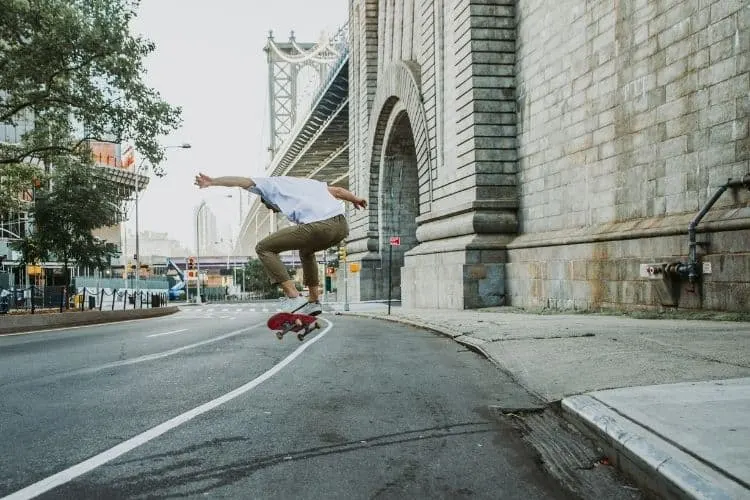
As you can see from the information above, a fakie flip is a great trick to learn. It’s a natural progression from a kickflip. It can also be tweaked to perform lots of much more impressive tricks, and best of all, it allows you to get better in another stance besides your most comfortable one.
Believe us, this is invaluable in a game of Skate. So use this guide as a means of learning this trick, and when you break it out at the park, don’t forget to give us a shout out!
FAQ Section
If you have reached the end of this article and still don’t have the answers you are looking for, you may find them in our FAQ section. Check it out below:
Answer: There is a similarity between these two stances as the skater will ultimately be in their natural foot position, unlike if they were riding switch.
However, the key difference between the two stances is that nollie happens when you are moving forward, and all tricks are popped at the nose, meaning that the dominant and flicking foot swap jobs and the trick is mirrored. Whereas a fakie trick is in the standard stance, but the board is traveling backwards.
Answer: We should say first of all that all tricks come to skaters at different speeds. That being said, some tricks are more attainable than others, and when it comes to tricks in the fakie stance, they are no different. We would say that the easiest of all fakie tricks about be the fakie ollie.
Much like the standard ollie, this is the foundation trick which you build your fakie trick catalogue off the back of. However, there are a few other fakie tricks that can be similarly easy to learn. Here is a quick list of those:
• Half cabs
• Fakie flips
• Fakie shuv-its
• Fakie big spins
• Fakie heels
Answer: This is a subtle difference that transition skaters will likely already be aware of. This is when a skater approaches a ramp in a standard stance. Then does their grind, stall, or trick in the air before descending down the ramp and riding away fakie. In simple terms, it means riding away from a transition trick in the fakie stance.
So that is our guide explaining all there is know about the Fakie Flip. What did you make of this article? Was this helpful and informative for you? What other tricks would you like to see us cover in the future. Let us know in the comments section below and as always, thank you for reading.
For more interesting readings check out:

